

La questiologie ou l'art de poser les bonnes questions: Frederic Falisse at TEDxPantheonSorbonne. #5 The Four Most Powerful Types of Creative Thinking. Considering I’m a creative coach, some people are surprised to learn I’m a little sceptical about creative thinking techniques.

For one thing, there’s a lot more to creativity than thinking. It’s possible to sit around having lots of creative thoughts, but without actually making anything of them. But if you start making something, creative ideas seem to emerge naturally out of the process. Future Proofing & Stargazing. The role of modern corporate boards is the juxtaposition of grounding and stargazing.
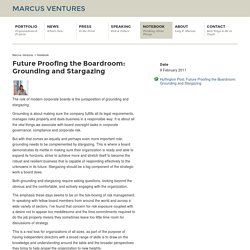
Grounding is about making sure the company fulfills all its legal requirements, manages risks properly and does business in a responsible way. It is about all the vital things we associate with board oversight tasks in corporate governance, compliance and corporate risk. But with that comes an equally and perhaps even more important role: grounding needs to be complemented by stargazing. This is where a board demonstrates its mettle in making sure their organization is ready and able to expand its horizons, strive to achieve more and stretch itself to become the robust and resilient business that is capable of responding effectively to the unknowns in its future. Stargazing should be a big component of the strategic work a board does. Both grounding and stargazing require asking questions, looking beyond the obvious and the comfortable, and actively engaging with the organization.
List of thought processes. Nature of thought[edit] Thought (or thinking) can be described as all of the following: An activity taking place in a: brain – organ that serves as the center of the nervous system in all vertebrate and most invertebrate animals (only a few invertebrates such as sponges, jellyfish, adult sea squirts and starfish do not have a brain).

It is the physical structure associated with the mind. mind – abstract entity with the cognitive faculties of consciousness, perception, thinking, judgement, and memory. Weak Signals Learning. Innovation frugale. Un article de Wikipédia, l'encyclopédie libre.
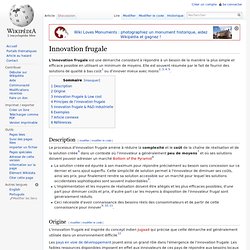
L'innovation frugale est une démarche consistant à répondre à un besoin de la manière la plus simple et efficace possible en utilisant un minimum de moyens. Transition design. Transition design is design led societal transition to a more sustainable future.
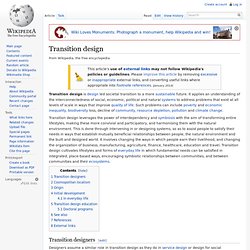
It applies an understanding of the interconnectedness of social, economic, political and natural systems to address problems that exist at all levels of scale in ways that improve quality of life. Such problems can include poverty and economic inequality, biodiversity loss, decline of community, resource depletion, pollution and climate change. Transition design leverages the power of interdependency and symbiosis with the aim of transforming entire lifestyles, making these more convivial and participatory, and harmonising them with the natural environment. This is done through intervening in or designing systems, so as to assist people to satisfy their needs in ways that establish mutually beneficial relationships between people, the natural environment and the built and designed world.
Transition designers[edit] Cosmopolitan localism[edit] Origin[edit] Breakthrough Thinking from Inside the Box. Imagine that we asked you to invent an idea for a new business in the next 20 minutes.

The task is so broad and vague that you would probably think you couldn’t do it. We have often seen people give up without really trying when confronted with such an amorphous challenge. Instead, let us pose a narrower question: What do Rollerblades, Häagen-Dazs ice cream, and Spider-Man movies have in common? The answer is they are all based on the same business concept.
Joi Ito: Want to innovate? Become a "now-ist" Complexity Thinking. Negative Thinking. A CEO calls her staff into the conference room on the eve of the launch of a major new initiative.
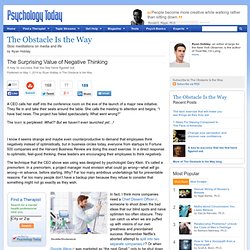
They file in and take their seats around the table. She calls the meeting to attention and begins, “I have bad news. The project has failed spectacularly. Captology. Captology is the study of computers as persuasive technologies.
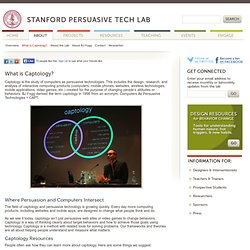
This includes the design, research, and analysis of interactive computing products (computers, mobile phones, websites, wireless technologies, mobile applications, video games, etc.) created for the purpose of changing people’s attitudes or behaviors. BJ Fogg derived the term captology in 1996 from an acronym: Computers As Persuasive Technologies = CAPT. Where Persuasion and Computers Intersect The field of captology and persuasive technology is growing quickly. La theorie C-K (pdf) Parallel thinking. Parallel thinking is a term coined and implemented by Edward de Bono.[1][2] Parallel thinking is described as a constructive alternative to "adversarial thinking", debate and in general the approach the GG3 (Greek gang of three) has been known to advocate.[3] In general parallel thinking is a further development of the well known lateral thinking processes, focusing even more on explorations—looking for what can be rather than for what is.
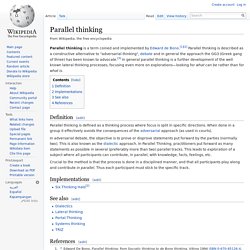
Definition[edit] Parallel thinking is defined as a thinking process where focus is split in specific directions. When done in a group it effectively avoids the consequences of the adversarial approach (as used in courts). In adversarial debate, the objective is to prove or disprove statements put forward by the parties (normally two). This is also known as the dialectic approach. Crucial to the method is that the process is done in a disciplined manner, and that all participants play along and contribute in parallel.
Generative Thinking. Lateral Thinking. Un article de Wikipédia, l'encyclopédie libre.
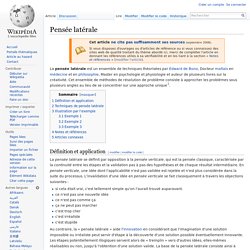
La pensée latérale est un ensemble de techniques théorisées par Edward de Bono, Docteur maltais en médecine et en philosophie, Master en psychologie et physiologie et auteur de plusieurs livres sur la créativité. Pensée convergente. Un article de Wikipédia, l'encyclopédie libre. La Pensée convergente est un terme inventé par Joy Paul Guilford en opposition à la pensée divergente[1].
En général, ce terme exprime la capacité à donner la réponse "correcte" à des questions standardisées qui ne requiert pas de créativité particulière. C'est une pensée qui utilise les connaissances et les capacités de raisonnement d'une personne pour obtenir une série de solutions à un problème donné et pour en sélectionner la seule correcte[2].
(en) Emotional Intelligence: Key Readings on the Mayer and Salovey Model, Port Chester, NPR Inc., 2004, 2e éd. Pensée divergente. Un article de Wikipédia, l'encyclopédie libre. La pensée divergente est un processus ou une méthode de pensée utilisée pour produire des idées créatives en envisageant de nombreuses solutions possibles. Ce concept est souvent utilisé en conjonction avec la pensée convergente, qui suit un ensemble particulier d'étapes logiques pour parvenir à une solution qui, dans certains cas, est une solution « correcte ». La pensée divergente se produit en principe dans un cadre spontané et non dirigé, de façon à ce que de nombreuses idées soient générées d'une façon aléatoire et non organisée. Plusieurs solutions possibles sont envisagées dans un court laps de temps, et des possibilités inattendues se dessinent.
Design Thinking. NeedFinding. Stratégie Océan Bleu. Thinking Futures – Futures Methods. There are a range of futures methods available to use. The links below will take to you information about methods that have been organised using the Generic Foresight Process, developed by Dr Joseph Voros. Joe describes the model helps to identify and separate out the stages that precede decision making about possible strategic options - that is, the strategic thinking hase of strategy development. The model highlights the need to use four stages, each with its own methods, in strategy development: input methods (what is happening out there?) ,analytical methods (what seems to be happening?) Only if each of these four stages are considered in the development of strategy can we begin to say that we have considered the future.
It is the combination of input, analysis, interpretation and prospection that helps to build a foresight capacity. Méthodes de prospective. Tutorial: Concrete vs. Abstract Thinking. WHAT ARE CONCRETE AND ABSTRACT THINKING? Abstract thinking is a level of thinking about things that is removed from the facts of the “here and now”, and from specific examples of the things or concepts being thought about. Abstract thinkers are able to reflect on events and ideas, and on attributes and relationships separate from the objects that have those attributes or share those relationships. 3 brilliant systems ideas THAT WILL EXPLODE IN YOUR FACE! Here are three brilliant systems ideas that will explode in your face. . “But..but.. he’s stark bollock naked!” , said the small boy to his mum. Working backward. See Maurice Ashley's blog here. He's the international chess grandmaster, and his motto is, "Your passion is your window to the world.
" In chess, retrograde analysis is a computational method used to solve game positions for optimal play by working backward from known outcomes (e.g. checkmate), such as the construction of endgame tablebases. 180-degree thinking/reversal. Micheal Michalko calls it "reversal of assumptions. " Tom Monahan calls it "180 Degree Thinking.
" Ultimately, it's about pushing your mind in the opposite direction to develop accidental or reverse directed brilliance. Professorial Stuff. Critical thinking. Critical thinking is a type of clear, reasoned thinking. According to Beyer (1995) Critical thinking means making clear, reasoned judgements. While in the process of critical thinking, ideas should be reasoned and well thought out/judged.[1] The National Council for Excellence in Critical Thinking defines critical thinking as the intellectually disciplined process of actively and skillfully conceptualizing, applying, analyzing, synthesizing, and/or evaluating information gathered from, or generated by, observation, experience, reflection, reasoning, or communication, as a guide to belief and action.
Conceptual thinking. Assessment | Biopsychology | Comparative | Cognitive | Developmental | Language | Individual differences | Personality | Philosophy | Social |Methods | Statistics | Clinical | Educational | Industrial | Professional items | World psychology | Cognitive Psychology:Attention · Decision making · Learning · Judgement · Memory · Motivation · Perception · Reasoning · Thinking - Cognitive processesCognition - OutlineIndex This article is in need of attention from a psychologist/academic expert on the subject.Please help recruit one, or improve this page yourself if you are qualified.This banner appears on articles that are weak and whose contents should be approached with academic caution Conceptual thinking can be a valuable analytic or problem solving tool in any field; for instance, Environment Canada in a note on “competencies meteorologists” defines it as follows: Conceptual thinking requires an openness to new ways of seeing the world and a willingness to explore.
See also Edit. Systemic Thinking. Analytical Thinking (PPT download) Integrative Thinking. Not one to put the cart before the horse, Roger Martin understands the importance of doing but he prefers “to swim upstream to the antecedent of doing: thinking.” Reactive Thinking. Visual thinking.